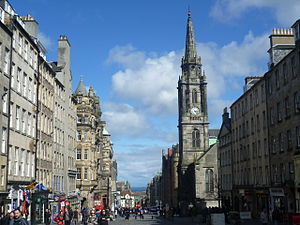Royal Mile: Difference between revisions
The Lawnmarket is a separately named part of the High Street. Addresses are a continuation of the High Street numbers. It runs from the West Bow to St Giles Street.
The Lawnmarket is a separately named part of the High Street. Addresses are a continuation of the High Street numbers. It runs from the West Bow to St Giles Street.
A charter of 1477 designated this part of the High Street as the market-place for what was called “inland merchandise” – items such as yarn, stockings, coarse cloth and other similar articles. In later years, linen was the main product sold. As a result, it became known as the Land Market{{cite web |url=http://maps.nls.uk/view/74400010#zoom=5&lat=3462&lon=3252&layers=BT |title=City and castle of Edinburgh, William Edgar, 1765 |work=Town Plans / Views, 1580-1919 |publisher=National Library of Scotland |access-date=2015-02-11 }} which was later corrupted to Lawn Market.{{cite web |url=https://www.scribd.com/document/57398403/Edinburgh-Street-Names |title=The Derivation of Edinburgh’s Street Names |access-date=2019-06-20 }}{{cite web |url=http://maps.nls.uk/view/74400070#zoom=5&lat=4745&lon=4785&layers=BT |title=City of Edinburgh, John Ainslie, 1780 |work=Town Plans / Views, 1580-1919 |publisher=National Library of Scotland |access-date=2015-02-11 }} Located in a close on the south side, Riddle’s Court is the well-preserved 16th-century of a merchant [[John MacMorran]], who was shot by rioting schoolboys in 1595.Daniel Wilson, ”Memorials of Edinburgh in the Olden Time”, vol. 1 (Edinburgh, 1891), pp. 218-219.
A charter of 1477 designated this part of the High Street as the market-place for what was called “inland merchandise” – items such as yarn, stockings, coarse cloth and other similar articles. In later years, linen was the main product sold. As a result, it became known as the Land Market{{cite web |url=http://maps.nls.uk/view/74400010#zoom=5&lat=3462&lon=3252&layers=BT |title=City and castle of Edinburgh, William Edgar, 1765 |work=Town Plans / Views, 1580-1919 |publisher=National Library of Scotland |access-date=2015-02-11 }} which was later corrupted to Lawn Market.{{cite web |url=https://www.scribd.com/document/57398403/Edinburgh-Street-Names |title=The Derivation of Edinburgh’s Street Names |access-date=2019-06-20 }}{{cite web |url=http://maps.nls.uk/view/74400070#zoom=5&lat=4745&lon=4785&layers=BT |title=City of Edinburgh, John Ainslie, 1780 |work=Town Plans / Views, 1580-1919 |publisher=National Library of Scotland |access-date=2015-02-11 }} Located in a close on the south side, Riddle’s Court is the well-preserved 16th-century of a merchant [[John MacMorran]], who was shot by rioting schoolboys in 1595.Daniel Wilson, ”Memorials of Edinburgh in the Olden Time”, vol. 1 (Edinburgh, 1891), pp. 218-219.
Today, the majority of shops in the street are aimed at tourists. On the north side is the preserved 17th century merchant’s townhouse [[Gladstone’s Land]] owned by the [[National Trust for Scotland]]. The lower end of the Lawnmarket is intersected by [[George IV Bridge]] on the right (south) and Bank Street on the left (north), leading to [[The Mound]] and the New Town. The view down Bank Street is closed by the [[baroque]] headquarters of the [[Bank of Scotland]].
Today, the majority of shops in the street are aimed at tourists. On the north side is the preserved 17th century merchant’s townhouse [[Gladstone’s Land]] owned by the [[National Trust for Scotland]]. The lower end of the Lawnmarket is intersected by [[George IV Bridge]] on the right (south) and Bank Street on the left (north), leading to [[The Mound]] and the New Town. The view down Bank Street is closed by the [[baroque]] headquarters of the [[Bank of Scotland]].
Tourist attraction in Edinburgh
Coordinates: 55°57′02″N 3°11′08″W / 55.95056°N 3.18556°W

The Royal Mile (Scottish Gaelic: Am Mìle Rìoghail)[1] is a succession of streets forming the main thoroughfare of the Old Town of the city of Edinburgh in Scotland. The term was first used descriptively in W. M. Gilbert’s Edinburgh in the Nineteenth Century (1901), describing the city “with its Castle and Palace and the royal mile between”, and was further popularised as the title of a guidebook by R. T. Skinner published in 1920, “The Royal Mile (Edinburgh) Castle to Holyrood(house)“.[2]
The Royal Mile runs between two significant locations in the royal history of Scotland: Edinburgh Castle and Holyrood Palace. The name derives from it being the traditional processional route of monarchs,[3] with a total length of approximately one Scots mile, a now obsolete measurement measuring 1.81km.[4] The streets which make up the Royal Mile are (west to east) Castlehill, the Lawnmarket, the High Street, the Canongate and…
Read More: Royal Mile: Difference between revisions

